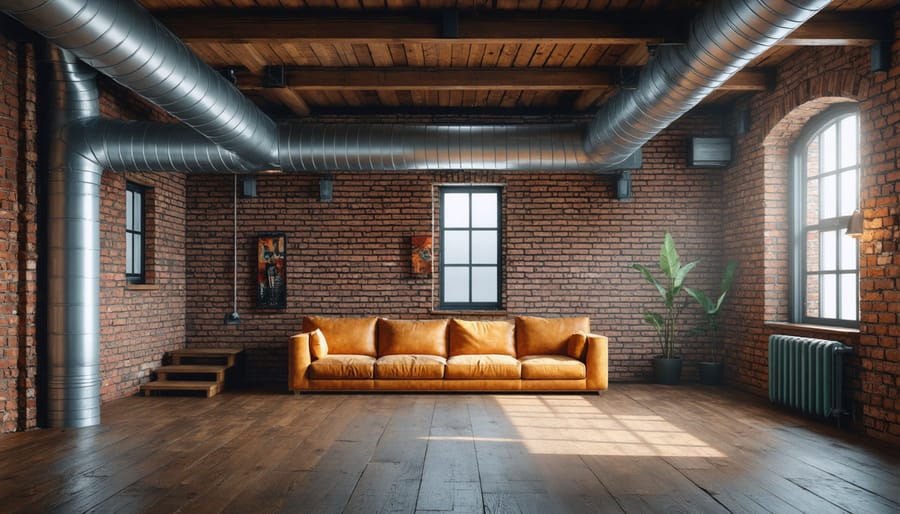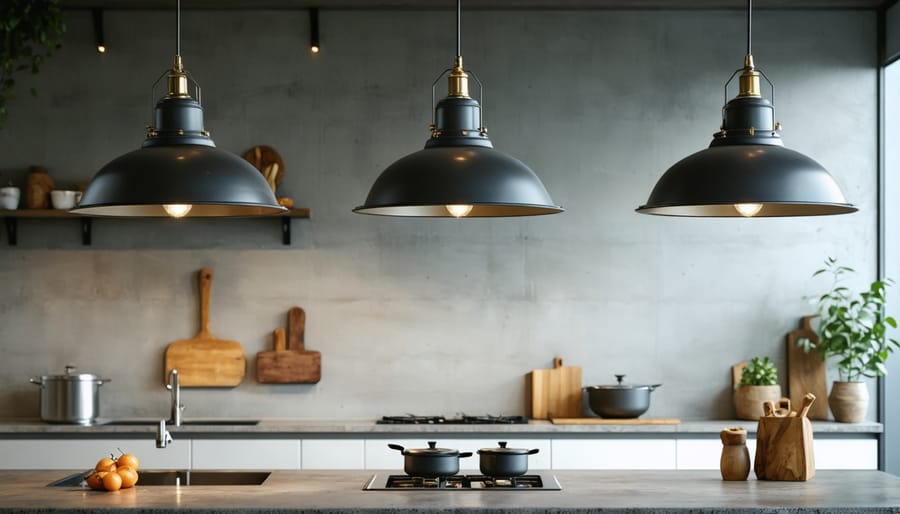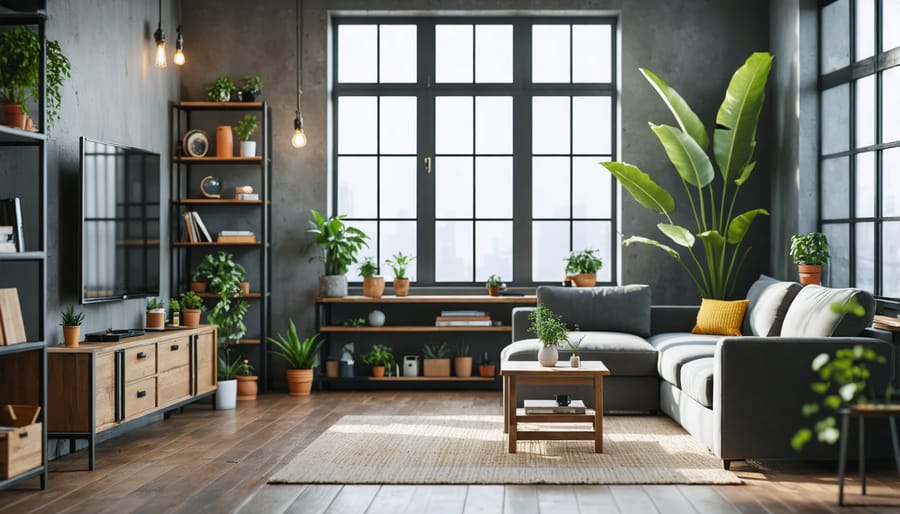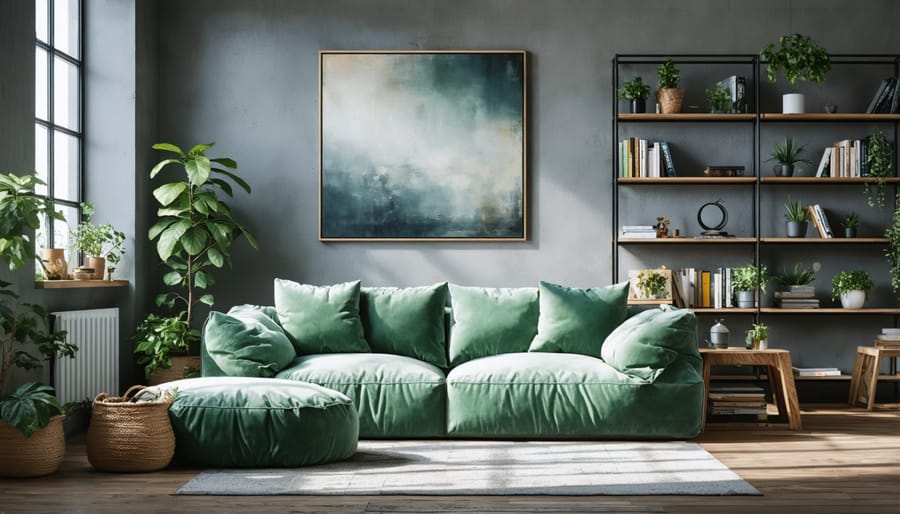Transform raw industrial spaces into sophisticated urban sanctuaries by embracing exposed brick walls, metallic fixtures, and weathered wood elements. The urban industrial design movement marries the raw authenticity of factory spaces with modern comfort, creating living environments that feel both edgy and welcoming. From converted warehouses to contemporary apartments, this design style celebrates architectural honesty through exposed ductwork, concrete floors, and steel accents while softening these hard elements with plush textiles and warm lighting.
Today’s urban industrial aesthetic has evolved beyond its utilitarian roots, offering a perfect balance between functionality and style. Whether you’re working with a true loft space or wanting to incorporate industrial elements into a conventional home, this design approach provides unlimited potential for personalization. By strategically combining vintage industrial pieces with contemporary furnishings, you can create a space that honors architectural heritage while meeting modern living needs.
This comprehensive guide will walk you through the essential elements of urban industrial design, from selecting the right materials and color palettes to incorporating statement pieces that define the style. Learn how to master the delicate balance between raw industrial elements and comfortable living spaces, creating an environment that’s both visually striking and perfectly livable.
The Essence of Urban Industrial Design
Raw Materials and Exposed Elements
The heart of urban industrial style lies in its celebration of raw, authentic materials that tell a story of architectural heritage. Concrete, with its cool gray tones and subtle imperfections, serves as a versatile foundation – whether it’s polished floors, exposed walls, or statement furniture pieces. Don’t worry if you can’t make structural changes; concrete-effect paint or tiles can create a similar industrial feel.
Metal elements add character and edge to your space. From steel beams and copper pipes to zinc countertops and iron light fixtures, these materials bring authentic industrial charm. Consider mixing different metal finishes – weathered brass, brushed nickel, and matte black can coexist beautifully while adding depth to your design.
Reclaimed wood adds essential warmth and natural texture, preventing the space from feeling too cold or stark. Look for wooden beams, barn doors, or vintage flooring with visible knots and grain patterns. Even modern wooden furniture with distressed finishes can help achieve this look.
Exposed architectural features are what truly set industrial interiors apart. Don’t hide those brick walls, ductwork, or electrical conduits – they’re design features worth showcasing. If your space lacks these elements naturally, you can carefully incorporate them through decorative touches like brick veneer or faux exposed piping.
Remember, the key is to balance these raw materials. Too much of any single element can overwhelm the space, while thoughtful combinations create that perfect industrial harmony.

Color Palettes and Textures
The urban industrial style embraces a raw, authentic color palette that draws inspiration from factory and warehouse environments. While following basic color wheel principles, this design approach primarily features neutral tones with strategic pops of color.
The foundation typically starts with shades of gray, from light concrete to deep charcoal, complemented by warm browns and blacks. These colors naturally emerge from exposed materials like steel, brick, and weathered wood. White walls can serve as a clean backdrop, making industrial elements stand out while preventing spaces from feeling too dark or heavy.
When it comes to textures, industrial design thrives on contrast. Smooth concrete surfaces play against rough brick walls, while polished metal fixtures complement distressed wood grain. Consider incorporating elements like:
– Distressed leather in cognac or deep brown
– Galvanized or blackened steel
– Raw concrete finishes
– Exposed brick in red or whitewashed tones
– Copper or brass accents for warmth
– Natural wood in various states of wear
For accent colors, consider deep blues, forest greens, or burgundy reds – colors that might have been found in old factories and workshops. These should be used sparingly through textiles, artwork, or smaller decor pieces to maintain the authentic industrial feel while adding visual interest to your space.
Key Elements That Make Industrial Design Work
Lighting Solutions
Lighting plays a crucial role in urban industrial design, where you can transform your home’s atmosphere with lighting choices that honor the style’s factory-inspired roots. Pendant lights with metal shades, exposed bulb fixtures, and adjustable wall sconces are signature elements that add authentic industrial character while providing functional illumination.
Natural light is equally important in this design style. Maximize window exposure by keeping treatments minimal – think simple roller blinds or bare windows when privacy allows. Large factory-style windows with black frames make a bold statement while flooding your space with daylight.
For task lighting, consider articulating desk lamps or pulley-system fixtures that combine functionality with industrial charm. Edison bulbs are popular choices for their warm glow and vintage appearance, though LED versions offer energy efficiency while maintaining the same aesthetic. Layer your lighting sources at different heights and intensities to create depth and flexibility in your space. Remember to include dimmers where possible to adjust the ambiance from bright and functional to cozy and intimate.

Furniture Selection
Selecting the right furniture is crucial for nailing the urban industrial look. Start with pieces that combine raw materials like metal and wood, which perfectly embody the style’s essence. Look for items that showcase exposed hardware, clean lines, and natural imperfections – these elements tell a story of craftsmanship and authenticity.
For seating, consider leather sofas with metal frames or canvas upholstery that ages beautifully over time. Vintage or vintage-inspired armchairs with visible steel components make excellent statement pieces. When it comes to dining furniture, opt for tables with cast iron bases topped with reclaimed wood, paired with metal chairs or industrial-style stools.
Storage solutions should lean towards open shelving units made from pipe fittings and wooden planks, or metal cabinets that might remind you of old factory lockers. Coffee tables featuring wheels or industrial casters add both functionality and style, while providing that authentic warehouse feel.
Don’t forget about accent pieces – think adjustable desk lamps with exposed bulbs, bar carts with metal frameworks, and side tables made from repurposed machinery parts. The key is to mix new pieces with genuine vintage finds to create a balanced, lived-in look.
Remember, comfort shouldn’t be sacrificed for style. Add softness through thoughtfully placed cushions and throws, using materials like leather, canvas, or worn denim to maintain the industrial aesthetic. The goal is to create a space that feels both raw and welcoming, where every piece serves a purpose while contributing to the overall industrial charm.
Architectural Details
The beauty of urban industrial design lies in celebrating a building’s original architectural elements rather than hiding them. Exposed brick walls, whether painted or in their natural state, serve as stunning focal points that tell a story of the space’s history. Don’t be afraid to showcase visible ductwork, pipes, and electrical conduits – these industrial elements add authentic character and visual interest to your space.
High ceilings with exposed beams or trusses are particularly valuable features to highlight. Consider leaving them unpainted to showcase their raw beauty, or paint them in dark colors for dramatic effect. Large factory-style windows are another architectural gem – keep them bare or use minimal window treatments to maximize natural light and maintain their industrial charm.
Concrete floors, whether polished or in their original state, perfectly complement the industrial aesthetic. If you have wooden floors, consider leaving them unfinished or applying a weathered look to maintain that warehouse-inspired feel. Original support columns can become striking design elements when left exposed or highlighted with architectural lighting.
Remember that imperfections tell a story – slight wear and tear, visible joints, and industrial markings add authenticity to your space. If your home lacks these architectural features, you can carefully incorporate salvaged industrial elements or create the illusion of them through thoughtful design choices and materials.
Practical Implementation Tips
Small Space Solutions
Living in a compact urban space doesn’t mean you have to compromise on industrial style. With some clever space-saving secrets for small apartments, you can create an impactful industrial aesthetic that maximizes every square foot.
Start by focusing on vertical space. Install floor-to-ceiling shelving units made from metal pipes and reclaimed wood, which not only provide storage but also reinforce the industrial look. Consider mounting light fixtures on walls instead of using floor lamps, and opt for pendant lights that draw the eye upward without consuming valuable floor space.
Multi-functional furniture is your best friend in small industrial spaces. Look for pieces like rolling kitchen islands that double as dining tables, or vintage trunks that serve as both coffee tables and storage. Industrial-style furniture often features slim profiles and open designs, which help maintain visual flow and prevent your space from feeling cramped.
Make strategic use of room dividers like metal-framed glass partitions or open shelving units to define different areas without blocking light or creating solid barriers. These elements can help organize your space while maintaining the industrial aesthetic.
For tiny apartments, consider scaling down typical industrial elements. Instead of full brick walls, incorporate smaller exposed brick sections or use brick-pattern wallpaper as an accent. Replace large machinery-inspired pieces with smaller vintage industrial accessories like desk lamps, wall clocks, or metal signs.
Remember that industrial style’s emphasis on raw materials and minimal decoration naturally complements small spaces, as it avoids cluttered, ornate details that can overwhelm compact rooms. Keep your color palette simple and consistent to create a cohesive look that makes your space feel larger.

Budget-Friendly Options
Creating an industrial-style space doesn’t have to drain your bank account. With some creativity and smart shopping, you can achieve that coveted urban industrial look while staying within budget. Start by exploring budget-friendly room makeovers that incorporate industrial elements gradually.
Consider visiting salvage yards, flea markets, and second-hand stores for authentic industrial pieces at fraction of retail prices. Old metal filing cabinets, vintage factory lights, and worn wooden crates can become statement pieces with minimal restoration. Paint existing furniture with metallic finishes to mimic industrial materials, or strip wooden pieces to expose their raw beauty.
For walls, skip expensive brick veneers and opt for textured wallpaper or paint techniques that create an industrial effect. Use concrete paint on floors instead of installing new flooring, or try peel-and-stick tiles with industrial patterns. Replace standard light fixtures with affordable pipe-style alternatives you can DIY using hardware store materials.
Shop end-of-season sales for industrial-style décor, and don’t overlook online marketplaces where you might find great deals on industrial furniture and accessories. Remember that imperfections are part of the industrial charm, so embrace pieces that show wear and tear.
Create impact with small changes: swap out regular switch plates for metal ones, replace traditional curtain rods with pipes, or display collections of vintage tools as wall art. The key is to focus on statement pieces that deliver the biggest visual impact while spreading out your purchases over time to manage costs effectively.
Mixing Styles
One of the most exciting aspects of urban industrial design is its versatility in combining with other interior styles. The raw, unfinished elements of industrial design create an excellent foundation for experimentation. By mixing antique and modern pieces, you can create a unique space that reflects your personality while maintaining the industrial core.
Try pairing industrial elements with Scandinavian minimalism for a softer, more livable feel. Add warm wood tones and cozy textiles to balance the cold metal surfaces. For a more luxurious twist, incorporate Art Deco touches through geometric patterns and metallic accents, or blend in mid-century modern furniture to add warmth and sculptural appeal.
Bohemian elements can soften industrial spaces through layered textiles, plants, and organic materials. Consider adding vintage Persian rugs over concrete floors or hanging macramé wall art against exposed brick. Contemporary pieces work particularly well with industrial elements, creating a sophisticated urban atmosphere.
The key to successful style mixing is maintaining balance. Let industrial elements serve as your base while introducing complementary styles through accessories, furniture, and textiles. Start with one or two pieces from another style and gradually build upon them until you achieve your desired aesthetic. Remember, the goal isn’t to mask the industrial elements but to enhance them through thoughtful combinations.

Common Mistakes to Avoid
While urban industrial design can create stunning spaces, there are several common pitfalls that can make your home feel cold or unfinished instead of stylishly industrial. One frequent mistake is going overboard with exposed elements – while raw pipes and ducts are characteristic of the style, too many can make a space feel cluttered and unrefined.
Another error is neglecting to balance hard surfaces with softer elements. Industrial doesn’t mean uncomfortable – incorporate plush textiles, area rugs, and cushions to create inviting spaces that people actually want to spend time in. Similarly, avoid using too much black and gray; while these colors are fundamental to industrial design, spaces need warmth through wood tones, plants, or warm metals like copper and brass.
Many homeowners also make the mistake of choosing low-quality reproductions of industrial pieces. Instead of buying cheap imitations, invest in a few authentic vintage items or high-quality modern pieces that will stand the test of time. Remember, industrial style celebrates craftsmanship and durability.
Lighting is another area where people often stumble. Relying solely on harsh, exposed bulbs can make a space feel like an actual factory rather than a comfortable home. Layer your lighting with a mix of industrial-style fixtures, task lighting, and ambient options to create a welcoming atmosphere.
Finally, don’t fall into the trap of making everything match perfectly. True industrial style embraces imperfection and organic development. Mix materials, combine different metal finishes, and allow some strategic “roughness” to maintain authenticity in your design.
Urban industrial interior design offers an exciting opportunity to transform your living space into something truly unique and personally meaningful. By embracing the raw beauty of industrial elements while maintaining comfort and functionality, you can create a home that tells your story while staying true to contemporary design principles.
Remember that successful industrial design isn’t about following strict rules – it’s about finding the right balance for your space and lifestyle. Start small by incorporating key elements like exposed brick, metal fixtures, or vintage industrial pieces. As your confidence grows, you can experiment with more dramatic features and combinations.
Don’t be afraid to mix and match different elements or adapt the style to suit your needs. Whether you’re working with a small apartment or a spacious loft, the versatility of industrial design allows for endless possibilities. Focus on quality materials, thoughtful lighting, and personal touches that make the space uniquely yours.
Most importantly, have fun with the process. Industrial design celebrates imperfection and authenticity, so there’s no need to aim for perfection. Start with a clear vision, but allow yourself the freedom to evolve and adapt as you go. With careful planning, creative thinking, and attention to detail, you can create an industrial-inspired space that’s both stylish and livable.
Consider this your invitation to explore the world of urban industrial design. Your perfect industrial-inspired home awaits – it’s time to start building it.
